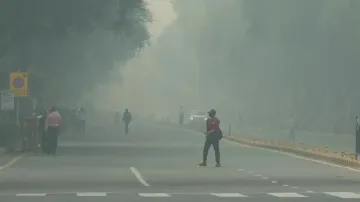Delhi's air quality improves slightly but remains hazardously high, AQI at 381
Delhi's air quality remains "very poor" with an AQI of 381, despite slight improvements, as smog continues to disrupt daily life and pose serious health risks.

After enduring over a week of hazardous air quality, residents of Delhi woke up to slightly improved conditions on Thursday morning, but the city's air quality remained dangerously high, with the Air Quality Index (AQI) still at 381, placing it in the "very poor" category.
Despite a marginal improvement, several areas across the national capital continued to record AQI levels exceeding 400, indicating the ongoing severity of the pollution crisis. According to the Central Pollution Control Board (CPCB), monitoring stations in Jahangirpuri and Wazirpur reported the highest readings at 437 and 419 respectively, followed by Ashok Vihar and Mundka, both recording 416. These figures place much of Delhi and surrounding areas in the "severe" air quality range, which has been causing widespread health concerns.
The Indian Meteorological Department (IMD) has forecasted a temperature range for Thursday, with a low of 11°C and a high of 26°C. However, the capital's skies remained heavily smogged, limiting visibility across the city.
At Indira Gandhi International Airport, thick smog led to reduced visibility, resulting in significant flight disruptions. As of now, 97 flights have been delayed, and 3 have been cancelled, according to flight tracking data from Flightradar. Airport authorities have advised passengers to check with airlines for updates on flight statuses.
The prolonged pollution has also affected nearby regions, including Noida, Ghaziabad, and Gurugram, where residents are facing similar air quality issues. In many parts of the National Capital Region (NCR), a blanket of smog continues to obscure the skyline and affect daily activities.
Here are the AQI readings from several locations across Delhi:
- Alipur: 408 (DPCC)
- Anand Vihar: 405 (DPCC)
- Ashok Vihar: 414 (DPCC)
- Aya Nagar: 359 (IMD)
- Bawana: 418 (DPCC)
- Chandni Chowk: 339 (IITM)
- CRRI Mathura Road: 343 (IMD)
- Dr. Karni Singh Shooting Range: 368 (IMD)
- DTU: 360 (CPCB)
- Dwarka-Sector 8: 401 (DPCC)
Health risks and concerns
The "very poor" and "severe" categories of air quality pose significant health risks, particularly for children, the elderly, and individuals with pre-existing respiratory or heart conditions. Experts have urged residents to limit outdoor activities, wear N95 masks, and take necessary precautions to avoid exposure to the toxic air.
Delhi's air quality has been deteriorating for over a week, with authorities taking multiple steps to mitigate the situation. However, the persistently high levels of pollution are primarily attributed to stubble burning in neighbouring states, vehicular emissions, and industrial activity. The city has also seen limited relief from weather conditions that might help disperse the pollutants.
Notably, an AQI between 0 and 50 is considered 'good', 51 and 100 'satisfactory', 101 and 200 'moderate', 201 and 300 'poor', 301 and 400 'very poor', 401 and 450 'severe', and above 450 'severe plus'.
While air quality has slightly improved compared to previous days, it remains a grave concern for Delhi residents. The city's pollution levels continue to be monitored closely, and authorities are urging immediate action to address the crisis.
As the smog continues to engulf the city, experts and environmentalists are calling for more long-term solutions, including stricter enforcement of pollution control measures and a concerted effort to reduce emissions from various sources.